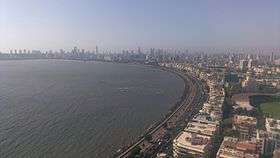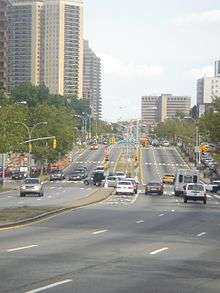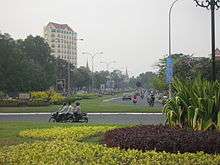Boulevard
A boulevard (French, from Dutch: Bolwerk – bulwark, meaning bastion), often abbreviated Blvd, is a type of large road, usually running through a city. These roads often replaced obsolete fortifications, hence the name.
In modern American usage it often means a wide, multi-lane arterial thoroughfare, divided with a median down the centre, and perhaps with roadways along each side designed as slow travel and parking lanes and for bicycle and pedestrian usage, often with an above-average quality of landscaping and scenery.
Larger and busier boulevards usually feature a median or central reservation. In some countries, the term boulevard is rarely encountered; the term avenue is often used instead.
International usage
Asia
Cambodia
Phnom Penh has numerous boulevards scattered throughout the city. Norodom Boulevard, Sisowath Boulevard, Monivong Boulevard, and Sothearos Boulevard are the most famous.
India
- Mumbai's Marine Drive is a 4.3 km long 'C' shaped coastal road located in South Mumbai along the Arabian Sea. It is also called the Queen's Necklace because if the stretch is viewed from an elevated point, the lamp posts along the road seem like pearls and thus in continuation look like a necklace. A promenade lies parallel to the road. It is one of the major tourist attractions in Mumbai. The Gateway of India is located just 1.7 km away from Marine Drive. Though rarely used, Marine Drive's official name is Netaji Subhash Chandra Bose Marg. Local residents use it for morning exercises as well. It is also popular among youths who come here to enjoy the splash of water during high tide.
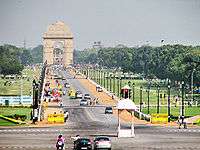
- New Delhi's premier boulevard is the Rajpath, which is also a thoroughfare. New Delhi being the national capital, many such thoroughfares were built widely to sustain the exploding traffic growth that New Delhi and most Indian metro cities have seen in recent decades. Rajpath, a tree lined road with ponds and fountains, was designed, along with Janpath, by British architect Edwin Lutyens during the British Raj. Various national events such as Independence Day parades and Republic Day parades among many others take place over here annually.
- Hyderabad's Necklace Road is a boulevard adjoining the Hussain Sagar lake.
- In Chennai, the major road is the Mount Road (Anna Salai). Another boulevard is Radakrishnan Salai, also called Cathedral Road, which is in Chennai in Tamil Nadu State in Southern India along the Bay of Bengal.
Iran
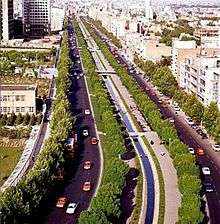
In Iran, "Boulevard" is generally defined as a wide road surrounded by trees in sides and divided by a green space line including grass, trees or buxuses in the middle. There are many boulevards in Iran. One of the most famous one is Keshavarz Boulevard in Tehran which is usually referred to as "The Boulevard". Isfahan has also a historical boulevard which is called Chaharbagh Boulevard.
Israel
Tel Aviv, established in 1909, was originally designed along the guidelines set out by architect Sir Patrick Geddes. Geddes designed a green or garden ring of boulevards surrounding the central city, which still exists today and continues to characterize Tel Aviv. One of the most famous and busy streets in the city is Rothschild Boulevard.
Philippines

Roxas Boulevard is a major boulevard in Metro Manila, Philippines. The boulevard, which runs along the shores of Manila Bay, is popular for its view of Manila's famous sunsets and stretch of coconut trees. The boulevard is an eight-lane major arterial road designated as Radial Road 1 that connects the center of Manila with Pasay and Parañaque.
Other boulevards in Metro Manila include the Shaw Boulevard, España Boulevard, Pedro Tuazon Boulevard and Quezon Boulevard. Not all boulevards in the Philippines have ornamentation, or slow lanes, like the Aurora Boulevard and E. Rodriguez Sr. Boulevard, which have no ornamentation at all.
Osmeña Boulevard is a boulevard in Cebu City, the Philippines' second city. It is Cebu's most important street and is its primary ceremonial avenue,[1] the conventional route of the city's civic and cultural parades. Measuring six to ten lanes wide with 3-5 meter-wide sidewalks on both sides and a landscaped central median, the boulevard is lined with narra trees. Midway is the park and roundabout of Fuente Osmeña.
Europe
Austria
The Ring Road (German: Ringstraße) is a circular ring road surrounding the Innere Stadt district of Vienna, Austria and is one of its main sights. Constructed in the mid-19th century after the dismantling of the city fortification walls, its architecture is typical of the eclectic, historicist style called Ringstraßenstil (Ring Road Style) of the 1860s to 1890s.
Known for its unique architectural beauty and history, it has also been called the "Lord of the ring roads", and is inscribed by UNESCO as part of Vienna's World Heritage Site.
The Ringstraße is 5.2 kilometers (3.2 miles) long and has several sections. It surrounds the central area of Vienna on all sides, except for the northeast, where its place is taken by the Franz-Josephs-Kai, the street going along the Donaukanal (a branch of the Danube). Starting from the Ringturm at the northern end of the Franz-Josephs-Kai, the sections are:
Schottenring (named after the Schottenstift) Universitätsring (university) Dr.-Karl-Renner-Ring (Karl Renner), formerly Parlamentsring Burgring (Hofburg) Opernring (Vienna State Opera) Kärntner Ring (named after Kärntner Straße, the road that led south to Carinthia) Schubertring (Franz Schubert) Parkring (Wiener Stadtpark) Stubenring (named after the Stubenbastei forticiation, part of Vienna's city walls since 1156)
France
Baron Haussmann made such roads well known in his re-shaping of Second Empire Paris between 1853 and 1870. The French word boulevard originally referred to the flat summit of a rampart (the etymology of the word distantly parallels that of bulwark which is a Dutch loanword [bolwerk]). Several Parisian boulevards replaced old city walls; more generally, boulevards encircle a city center, in contrast to avenues that radiate from the center.
Boulevard is sometimes used to describe an elegantly wide road, such as those in Paris, approaching the Champs-Élysées. Famous French boulevards: Avenue Montaigne, Montmartre, Invalides, Boulevard Haussmann. Frequenters of boulevards were sometimes called boulevardiers
Germany
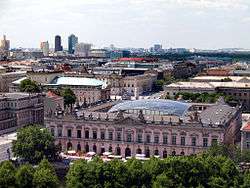
The historically most famous boulevard in Berlin and arguably in all of Germany is Unter den Linden: location of the Berlin State Opera, Berlin Cathedral, the former royal palace, Humboldt University, the Neue Wache state memorial, the Germany Historical Museum housed in the old arsenal and Brandenburg Gate being the boulevard's focal point. Most famed for its classy shopping facilities is Berlin's Kurfürstendamm.
In the 1920s it was considered one of the most cosmopolitan places in Europe, being not only an elegant residential area but also a major centre of nightlife and leisure. Ku'damm retained this air throughout the Cold War becoming the hub of free West-Berlin. Still today it is the city's most frequented shopping district.
A notable boulevard in Berlin's East is Karl-Marx-Allee, which was built primarily in the 1950s in Stalinist Classicism architecture with decorative buildings. One section of the boulevard is more decorative while the other is more modern. In the center of the boulevard is the Strausberger Platz, which has buildings in wedding-cake style. The boulevard is divided into various blocks. Between 1949 and 1989, it was the main center of East Berlin. The Königsallee in Düsseldorf is known for its many famous fashion stores and showrooms.
Hungary
The Hungarian capital Budapest is also known for its well planned street system with wide avenues and boulevards, running through the city. There are three main boulevards, named Little Boulevard, Grand Boulevard and Hungária Boulevard. Little Boulevard was built on the demolished medieval city walls of Pest in the late 19th century. Grand Boulevard, the most prominent, was built for the 1000th anniversary of the Hungarian conquest in 1896. It has a uniform facade, and the busiest tram line in Europe.[2]
Hungária Boulevard was built from 1980 to 2000 and it is the widest (70 meters, like Champs-Élysées) and longest (13 kilometers) boulevard in Budapest with six to ten traffic lanes and a rapid tram line. Although the construction of the boulevard was finished in 2000, the facade is still incomplete, as there are many empty parcels due to demolition of old apartments and factories.
Ireland
As in the UK, Ireland also has a lack of boulevards, but O'Connell Street in Dublin is one of Europe's widest streets and is very like a Victorian boulevard. In recent housing developments in Dublin, the boulevard is becoming more and more common in addresses (e.g. Tyrellstown Blvd, Park Blvd, Bayside Blvd), and a boulevard was opened in Gorey, County Wexford in early 2015.
Italy
Florence's historic centre, for example, is surrounded by the Viali di Circonvallazione, a series of 6-lane wide streets; the boulevards follow the outline of the ancient walls of Florence, that were demolished since 1865 to make Florence, then the capital of Italy (for 5 years, 1865–1870), a modern and big city like the other European capitals. The Viali were inspired by the similar Parisian boulevards.
Poland
Boulevards are representative places in cities situated near big rivers and usually parts of their centres, for example in Cracow, Warsaw, Toruń, Bydgoszcz, Gdańsk, Gorzów Wielkopolski, Wrocław and Świnoujście.
One of the most famous boulevards in Poland is the street named Wały Chrobrego (former German name: Hakenterrasse) in Szczecin, where the final events of The Tall Ships' Races took place in 2007 and 2013. This is about 100 years old street complex at the river bank of Oder with some connections to the harbour in Szczecin and the Baltic Sea. There are many tourist attractions e.g. National Museum in Szczecin, The Contemporary Theater (Teatr Współczesny), Statue of Hercules fighting the Centaur and the waterfront for ships, including harbour cruise ships and hydrofoil to Świnoujście. In the area there are more historic buildings situated, for instance The Ducal Castle.
Some tourist towns and villages are known among others from their boulevards and esplanades. There are many localities situated by the sea, for example Sopot, Gdynia, Kołobrzeg, Międzyzdroje and Świnoujście, or other types of big water areas as Trzebież lying on the Szczecin Lagoon. Feliks Nowowiejski Seaside Boulevard in Gdynia was the first stage of the Tour de Pologne in 2003. Boulevards are also representative places in Gryfino (dictrict town in Poland) and German village Mescherin localized by both sides of the valley of Oder river protected with Lower Odra Valley Landscape Park.
There are also many boulevards by lakes and small rivers, mainly in harbours areas, as in Giżycko, and in urban parks, for example in Łobez, Piotrków Trybunalski, Poznań and the oldest Polish urban park in Kalisz founded in 1798. Boulevards and paths in Łazienki Park in Warsaw surround Palace on the Water. The medieval port crane, called Żuraw, over Motława river, the junction of two boulevards - Długie Pobrzeże and Rybackie Pobrzeże - is the symbol of the medieval harbour of Gdańsk. The Old Town Promenade (Promenada Staromiejska) in Wrocław was built on the former on the former defensive fortifications along the City Moat and a small section along the Oder river. The boulevard in Kasprowicz Park in Szczecin leads along Rusałka Lake from the City Hall area to The Summer Theater (Teatr Letni) and then to Różanka Rose Garden and the forest of Puszcza Wkrzańska. The scenic above ground promenade in Augustów enables the observation of the Augustów Canal and national roads 8 and 16.
Russia
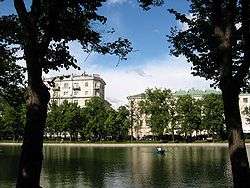
The dictionary defines boulevard as a wide green strip in the middle of a city street or on the embankment.[3] Historical Boulevard Ring in Moscow emerged on the site of the former White City walls (demolished in 1760s and 1770s) before the Fire of 1812, starting with Tverskoy Boulevard in 1796.[4] The whole ring was replanted and rebuilt after the fire, in 1820s; together with the embankments of Moskva River the boulevards form the second centremost city ring.
Green boulevards of that period were terminated with corner hotel and shop buildings, most of them eventually demolished to make way for street traffic. Garden Ring, developed in the middle of 19th century, had traditional median boulevards in its western part and side gardens in the east (streets with side strips of green, even those separating main traffic and frontage roads, are not usually considered boulevards).
Street names of Saint Petersburg evolved differently: median greens of major avenues were called boulevards, but the avenues themselves typically were and still are called prospekts (i.e. Bolshoy Prospekt of Vasilievsky Island).
United Kingdom
Owing to city planning and physical geography, the UK has only a few boulevards. Glasgow's Mosspark Boulevard, a former segregated tram and car wide road along Bellahouston Park, and Great Western Road, colloqially known as 'The Boulevard' north of the River, is a good example, a mostly dual carriageway road running to the outer suburbs passing through the fashionable West End district, with many shops and bars dotted along the route.
After the Great Fire of London, London was supposed to be formed of straight boulevards, squares and plazas which are seen in mainland Europe, but due to land ownership issues these plans never came to fruition. Boulevards in London are rare but examples, such as Blackfriars Road, do exist. Milton Keynes, Buckinghamshire, is one of only a handful of examples where boulevards are a key feature. This is due to Milton Keynes being built as a modern new town in the 1960s.
Nottingham also has an extensive network of boulevards, although some lower-capacity highways are named boulevards even when they are streets (for example Gilbert Boulevard, Arnold)[5] Furthermore, the north-west town of Warrington in Cheshire has a large number of boulevards, some more recent than others. Lining the Gemini Retail Park in Warrington is Europa Boulevard with the traditional tree lined pavements and two-lane traffic. Also, on the recent housing development, Chapelford - built on the old Burtonwood Airbase site, are a number of boulevards such as Boston and Santa Rosa Boulevard, built in reference to the American history associated from World War II on the site.
Turkey

Barbaros Boulevard is opened in 1958 due to new city planning in Istanbul. Ankara also has a lot of boulevards.
North America

Dominican Republic
In the Dominican Republic, more specifically in Greater Santo Domingo there is the Winston Churchill and 27 de Febrero Boulevard in Downtown Santo Domingo and Las Americas Boulevard in Santo Domingo Este. These boulevards are known for their wide median with plazas and trees on it.
Mexico
Paseo de la Reforma (English: "Reform Promenade") is a 12 kilometer long boulevard in Mexico City, Mexico that runs in a straight line, cutting diagonally across the city. It runs from Chapultepec Park, then passes alongside the Torre Mayor (currently Latin America's tallest building), continues through the fashionable Zona Rosa and then to the Zócalo by Juárez Avenue and Francisco I. Madero Street. One of the most famous monuments of the Paseo is El Ángel de la Independencia – a tall column with a gilded statue of a Winged Victory on its top and marble statues at its base depicting the heroes of the Mexican War of Independence.
The Paseo de la Reforma was designed in the 1860s during the Second Mexican Empire by the Austrian military officer and engineer Ferdinand von Rosenzweig on the orders of Maximilian I of Mexico. He wanted to connect his imperial residence, Chapultepec Castle, to the Palacio Nacional in the city's center. When it was inaugurated, it was named the Paseo de la Emperatriz (The Empress's Promenade), after his consort, Empress Carlota of Mexico. The name now commemorates the liberal reforms of 19th century president Benito Juárez.
United States and Canada
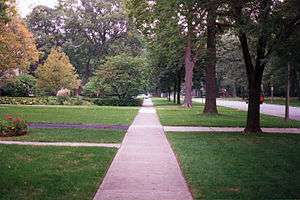
In many places in the United States and Canada, municipalities and developers have adapted the term to refer to arterial roads, not necessarily boulevards in the traditional sense. In California, many so-called "boulevards" extend into the mountains as narrow, winding road segments only two lanes in width. However, boulevards can be any divided highway with at-grade intersections to local streets. They are commonly abbreviated Blvd. Some celebrated examples in California include:
- Sunset Boulevard in San Francisco, which has rows of trees on both sides of the thoroughfare, and is bisected by a tree-filled median. It connects local streets throughout the Sunset District.
- The Los Angeles area's more famous Sunset Boulevard; Santa Monica Boulevard; Wilshire Boulevard; and Hollywood Boulevard. Many important thoroughfares in Los Angeles are boulevards.
In Chicago, the boulevard system is a network of wide, planted-median boulevards that winds through the south, west, and north sides of the city and includes a ring of parks. Most of the boulevards and parks are 3–6 miles from The Loop. Trucks are not allowed on boulevards in Chicago. Seattle also features a network of boulevards that connect most of the city's public parks to each other, a design recommended by the Olmsted Brothers.[6]
In Philadelphia, the boulevard system includes the length of the Benjamin Franklin Parkway known as the Museum District. It also includes the arterial roadway of the Roosevelt Boulevard and the Southern Boulevard Parkway built as a connecting median of two urban parks, but now also serves as the west roadway entrance of the world class centralized Philadelphia Sports Complex and gatehouse entrance of the Philadelphia Navy Yard in South Philadelphia.
Sometimes, the word "boulevard" is used as a standalone name, as is the case in Atlanta, and Roosevelt Boulevard in the Northeast section of Philadelphia is sometimes referred to, chiefly by locals, simply as "The Boulevard." In Pittsburgh, "The Boulevard of the Allies" runs through and connects major areas of the city.
Kansas City, Missouri and St. Louis, Missouri are famous for having more boulevards and avenues in the world than any city (if the term is used lightly). In Charlotte, North Carolina, Independence Boulevard connects Uptown to the southeastern section of the city, although the westernmost segment is actually a freeway.
New York City has a lot of boulevards, many of which are not designated as such (like Ocean Parkway or Broadway). In the borough of Queens, many important thoroughfares are designated as Boulevards.
Nineteenth century parkways, such as Brooklyn's Ocean Parkway, were often built in the form of boulevards and are informally referred to as such. In some cities, however, the term "boulevard" does not specify a larger, wider, or more important road. "Boulevard" may simply be used as one of many words describing roads in communities containing multiple iterations of the same street name (such as in the Ranchlands district of Calgary, where Ranchlands Boulevard exists side-by-side with Ranchlands Road, Ranchlands Court, Ranchlands Mews, etc.) Nowadays boulevards can be found most anywhere and their original structured meaning has lost almost all meaning.
Lake Shore Boulevard, a six-lane thoroughfare runs along the lakefront in Toronto from Woodbine Avenue in the east to the city limits in the west. The section between Jameson Avenue and the Humber River (the original section), as an example of urban planning, was laid out to provide a pleasant drive with a view of Humber Bay on Lake Ontario and easy access to the park lands by automobile. It was later expanded for commuting.
A famous American example is Las Vegas Boulevard in Las Vegas, Nevada.
Oceania
Australia
Melbourne has at least four roads named "the Boulevard." These are, generally, long roads with many curves which wind alongside the Yarra River. In addition, the spelling of boulevard with an extra 'e' is common, for example the Southlands Boulevarde shopping centre in southern Perth. Australia post officially abbreviates boulevard as "BVD".[7]
Several Melbourne thoroughfares not named as a boulevard do in fact follow the boulevard configuration of multiple lanes and landscaping. These include St Kilda Road, Royal Parade, Victoria Parade, Flemington Road, and the outer section of Mount Alexander Road.
Boulevards in Sydney include:
- Norwest Boulevard in Bella Vista and Baulkham Hills,
- The Boulevard in the City of Canterbury, which runs through Punchbowl, Wiley Park and Lakemba
- The Boulevard in the City of Fairfield, which runs through Canley Vale, Fairfield, Fairfield West, Fairfield Heights and Smithfield.
- The Boulevarde in Inner West Council, which runs through Dulwich Hill, Lewisham and Petersham.
- The Boulevarde in the Sutherland Shire, which runs through Sutherland, Kirrawee, Gymea, Miranda and Caringbah.
Additionally, single-suburb boulevards are situated in Brighton-le-Sands, Cammeray, Cheltenham, Epping, Lidcombe, Lilyfield, Malabar, Newport, Sans Souci, Strathfield and Yagoona.
New Zealand
Construction began on the Orewa Boulevard in March 2009, the works are expected to be complete by February 2010. This boulevard will be approximately 400 m long with Pohutukawa and palm lined footpaths, a wide cycleway will be constructed on the beach side of the road and carparks on the business side. The Orewa Boulevard is a project commissioned by the Rodney District Council with the vision of connecting the CBD to Orewa Beach.
Central Christchurch is surrounded and connected by a series of large boulevards (usually called "avenues" in New Zealand). These include four which surround the central city, Bealey Avenue, Fitzgerald Avenue, Deans Avenue, and Moorhouse Avenue, and also Riccarton Avenue, which traverses the large central city park, Hagley Park. The centre of the city is often described locally as being "within the Four Avenues".[8]
South America
Argentina
Avenida 9 de Julio in the heart of Buenos Aires, which is the capital city of Argentina, is as wide as 7 lanes in each direction, with 4 further lanes flanking the main boulevard in parallel roads on either side.
Uruguay
In Montevideo, Artigas Boulevard is an important avenue (40 m wide) that encloses the central area.
References
- ↑ "Buses to Bring Change". Cebu Daily News.
- ↑ Rebuilt of tram 4-6
- ↑ "Boulevard". (Russian: бульвар)
- ↑ "Boulevards of Moscow (in Russian)".
- ↑ https://maps.google.com/maps?q=Gilbert+Boulevard,+Arnold,+Nottingham,+Nottinghamshire+NG5+7NA,+United+Kingdom
- ↑ "Seattle Parks and Recreation: Park History - Olmsted Parks". Seattle.gov. 2011-07-21. Retrieved 2012-01-27.
- ↑ (PDF) http://www.auspost.com.au/GAC_File_Metafile/0,,4099_2010_amas_handbook_15_19_v1_0,00.pdf. Retrieved November 25, 2009. Missing or empty
|title=(help) - ↑ For example: (1) "Reduced traffic capacity on key routes within the Four Avenues from next week", Transport of Christchurch. 19 April 2013. Retrieved 27 April 2013; (2) Wagner, Nicky "Within the Cordon - living inside the Four Avenues", RebuildChristchurch. Retrieved 27 April 2013.
Books
- Jacobs, Allan B.; Elizabeth Macdonald; Yodan Rofé (2003). The Boulevard Book. The MIT Press. ISBN 0-262-60023-4.
| Look up boulevard in Wiktionary, the free dictionary. |
